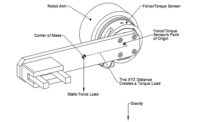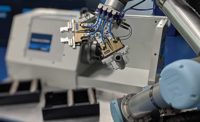BLDC motors use electronic instead of mechanical commutation to control the power distribution to the motor. Latching Hall-effect sensors, mounted in the motor, are used to measure the motor’s position, which is communicated to the electronic controller to spin the motor at the right time and right orientation. These Hall-effect sensors are operated by a magnetic field from a permanent magnet or an electromagnet, responding to South (operate) and North (release) poles. These magnetic sensors determine when the current should be applied to the motor coils to make the magnets rotate at the right orientation.
There are several design characteristics that BLDC motor manufacturers should evaluate when selecting a bipolar latching Hall-effect sensor to commutate the motor so it can operate as efficiently as possible. These include sensitivity, repeatability, stability-over-temperature, and response time.
Sensitivity
A magnetic field is required to activate a Hall-effect sensor. Sensitivity level is based on the placement of the sensor to the magnet, the air gap, and magnet strength. Product datasheets should indicate the magnetic field strength (measured in Gauss), required to make a bipolar Hall-effect sensor change state (operate and release).
A high-sensitivity sensor, typically rated at less than 60 Gauss, allows for the use of smaller magnets or less expensive magnetic materials, increasingly important as the prices for rare earth magnets continues to increase. High sensitivity also allows for a wider air gap, which means the sensor can be placed further away from the magnet and still be very reliable, while providing some design flexibility. Or given the same air gap, the sensor is more sensitive, thus delivering higher reliability and repeatability. This means a Hall-effect sensor with high sensitivity or a lower magnetic switch point delivers more efficient motor performance.
As an example, Honeywell Sensing and Control’s SS360ST, SS360NT, and SS460S high sensitivity bipolar latch Hall-effect sensors operate from only 30 Gauss typical at 25 °C, and 55 Gauss maximum over the full operating temperature range of -40 °C to 150 °C. This allows for the installation of lower-cost commutation magnetics and the design of smaller products.
Repeatability
Repeatability refers to the Hall-effect sensor’s latching time. It goes hand-in-hand with high sensitivity, as it allows the sensor to be more repeatable. When the sensor output turns on, it directs current through the coil windings in the stationary part of the motor. This current produces a magnetic field that interacts with the field from the permanent magnets on the shaft and causes the shaft to spin.
As the magnet rotates past the sensor, a highly repeatable sensor changes state at the same angular position each time the magnet passes by. For example, one complete revolution of the motor shaft is 360 degrees. If the sensor turns on at five degrees when the shift spins the first time, does it change state at five degrees at the next rotation? A highly repeatable sensor is one that has a consistent response time, which will maintain all of the angular measurements very close to the same value. In this case, at five degrees.
Why is this important? To produce the maximum amount of torque on the shaft, the timing between current flowing through the coil and the position of the shaft must be as accurate as possible. If there is a delay in the sensor’s response to changes in the magnetic field, this slower response can lead to lower bandwidth and accuracy errors. Any error in the switching point of the Hall-effect sensor will reduce the torque of the motor, which results in lower motor efficiency.
Stability
Similar to repeatability, stability refers to how much the angular position changes, but in this case, versus temperature or voltage. For example, if the sensor output changes state at five degrees at 25 °C, where does it change state at 125 °C? The Gauss level required to turn a part on at 125 °C needs to be as close as possible to the Gauss level required to turn a part on at 25 °C. So, if a part operates at 30 Gauss at 25 °C, does it operate around 30 Gauss at 125 °C, or does the operate point shift to, for example, 50 Gauss or 5 Gauss?
Honeywell Sensing and Control’s SS360ST, SS360NT, and SS460S high sensitivity bipolar latch Hall-effect sensors have operate and release points that are nearly magnetically symmetrical over the operating temperature range. This means a sensor operating at positive 30 Gauss will release at approximately negative 30 Gauss.
This is important because stability-over-temperature, coupled with high sensitivity, is needed for precise position detection. Magnetic stability also helps improve jitter performance, which is critical for BLDC efficiency, and results in less speed variation.
Response time
Response time is the time it takes for the output of the sensor to change state. For example, if a sensor has an operating point of 30 Gauss, and a 30 Gauss magnetic field level is applied to the sensor, the response time is measured from the point when the 30 Gauss field is applied to when the output changes state.
A faster response time to a change in the magnetic field delivers greater efficiency in commutating a BLDC. If a sensor switches at a different magnetic field level than what is required due to slow response or delay, this could result in accuracy errors.
Motors need to switch at a very specific point to achieve the highest efficiency. Miscommutation results in lower effective torque constant (Kt) and higher torque ripple that can cause additional noise as well as impact efficiency and system performance.
It’s also important to note that sensor manufacturers have achieved high sensitivity and stability-over-temperature by using a technique called chopper stabilization. This results in a highly repeatable and stable sensor over the operating temperature range using single or dual Hall-effect sensing elements. However, this technique can affect motor efficiency due to several disadvantages including slow response time and increased electrical noise.
Honeywell Sensing and Control’s sensors eliminate the need for chopper stabilization by using a quad Hall-effect sensor, instead of a single or dual Hall-effect element, together with proprietary software, to account for any drift in the switch point. These sensors also exhibit a fast response time, reduce sensitivity to packaging stresses, and produce less noise. This results in improved motor efficiency.
Don’t underestimate the value of Hall-effect sensors in BLDC designs. These tiny devices shouldn’t be an afterthought during the design process as they have a big impact on motor efficiency. Designers need to look closely at several specifications including sensitivity (60 Gauss rating or less), repeatability (changes state at the same angular position each time the magnet passes by), stability (operate and release points virtually symmetrical over the temperature range), and response time (switching as close to the change in the magnetic field level).







